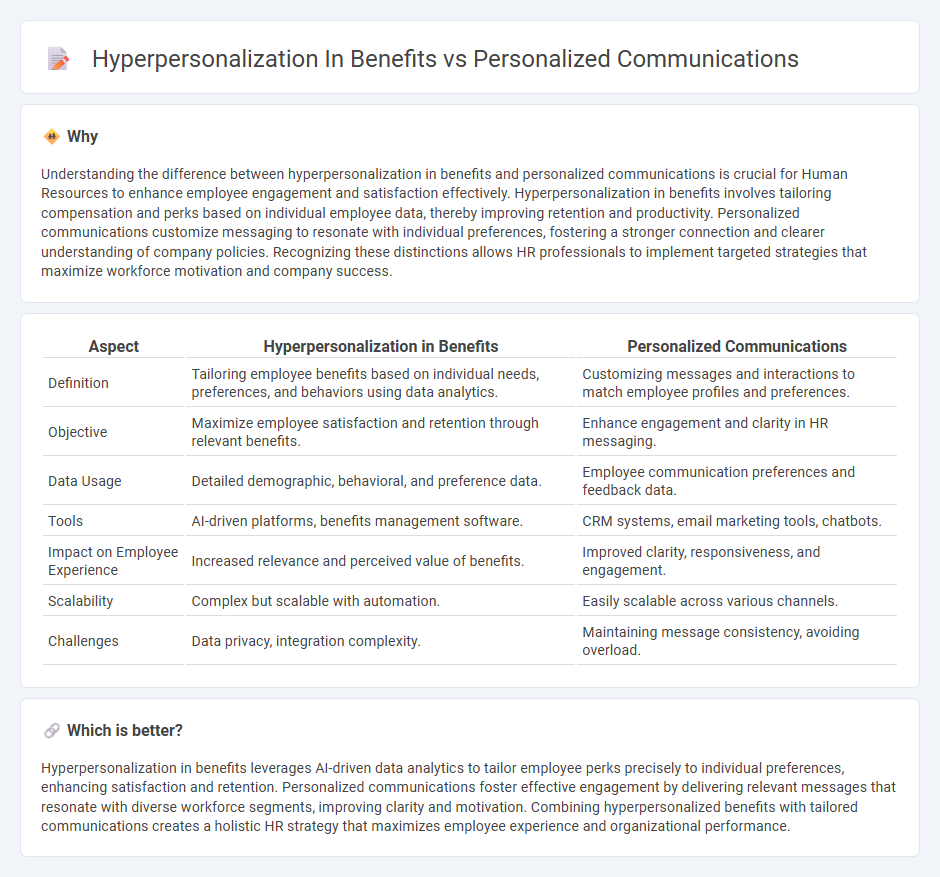
Hyperpersonalization in benefits leverages advanced data analytics and AI to tailor employee offerings precisely to individual needs, surpassing the scope of personalized communications that focus mainly on messaging customization. By integrating dynamic employee preferences, health data, and behavioral insights, hyperpersonalized benefits programs enhance engagement, satisfaction, and retention more effectively. Discover how hyperpersonalization is transforming employee experience and driving measurable business outcomes.
Why it is important
Understanding the difference between hyperpersonalization in benefits and personalized communications is crucial for Human Resources to enhance employee engagement and satisfaction effectively. Hyperpersonalization in benefits involves tailoring compensation and perks based on individual employee data, thereby improving retention and productivity. Personalized communications customize messaging to resonate with individual preferences, fostering a stronger connection and clearer understanding of company policies. Recognizing these distinctions allows HR professionals to implement targeted strategies that maximize workforce motivation and company success.
Comparison Table
| Aspect | Hyperpersonalization in Benefits | Personalized Communications |
|---|---|---|
| Definition | Tailoring employee benefits based on individual needs, preferences, and behaviors using data analytics. | Customizing messages and interactions to match employee profiles and preferences. |
| Objective | Maximize employee satisfaction and retention through relevant benefits. | Enhance engagement and clarity in HR messaging. |
| Data Usage | Detailed demographic, behavioral, and preference data. | Employee communication preferences and feedback data. |
| Tools | AI-driven platforms, benefits management software. | CRM systems, email marketing tools, chatbots. |
| Impact on Employee Experience | Increased relevance and perceived value of benefits. | Improved clarity, responsiveness, and engagement. |
| Scalability | Complex but scalable with automation. | Easily scalable across various channels. |
| Challenges | Data privacy, integration complexity. | Maintaining message consistency, avoiding overload. |
Which is better?
Hyperpersonalization in benefits leverages AI-driven data analytics to tailor employee perks precisely to individual preferences, enhancing satisfaction and retention. Personalized communications foster effective engagement by delivering relevant messages that resonate with diverse workforce segments, improving clarity and motivation. Combining hyperpersonalized benefits with tailored communications creates a holistic HR strategy that maximizes employee experience and organizational performance.
Connection
Hyperpersonalization in benefits utilizes advanced data analytics and AI to tailor employee perks to individual preferences, increasing engagement and satisfaction. Personalized communications complement this by delivering targeted messages that resonate with specific needs, fostering a stronger connection between employees and organizational offerings. Together, they create a synergistic HR strategy that enhances retention and productivity.
Key Terms
Segmentation
Personalized communications use broad segmentation based on demographics or behavior to tailor messages for groups, enhancing relevance and engagement. Hyperpersonalization leverages real-time data, AI, and individual preferences to create uniquely tailored experiences that drive higher conversion rates and customer loyalty. Explore how advanced segmentation boosts impact by unlocking deeper customer insights and precision targeting.
Data Analytics
Personalized communications leverage basic customer data such as demographics and purchase history to tailor messaging, improving engagement and conversion rates. Hyperpersonalization uses advanced data analytics, including behavioral patterns and real-time data, to create more precise and dynamic customer experiences, significantly enhancing ROI and customer loyalty. Explore how integrating cutting-edge data analytics tools can elevate your marketing strategy today.
Predictive Personalization
Predictive personalization enhances personalized communications by leveraging AI-driven data analytics to anticipate customer needs and deliver highly relevant content, improving engagement and conversion rates. Unlike standard personalized communications that rely on basic demographic and behavioral data, hyperpersonalization incorporates real-time context and predictive insights for more precise targeting. Explore how predictive personalization transforms customer experiences and maximizes benefits in marketing strategies.
Source and External Links
How to Use Personalized Communication to Improve Engagement - This article discusses how personalized communication can enhance customer engagement by tailoring messages based on individual needs and preferences.
Improving Customer Engagement with Personalized Communications - This case study highlights the role of personalization in improving customer retention through one-to-one marketing strategies.
Personalize Client Communications for Better Retention - This blog post emphasizes the importance of personalized communications in building stronger client relationships, particularly in the financial sector.
 dowidth.com
dowidth.com